Auteur/autrice : C&A HD

Cadences/Cadenzas: Ferrucio Busoni
Walter Gieseking, Baldwin piano – Guido Cantelli New York Philharmonic (NYPO)
Carnegie Hall – March 6, 1955
Source: Bande / Tape – 19 cm/s / 7.5 ips
Cette interprétation du 6 octobre 1955 documente la rencontre entre Gieseking et Cantelli. C’est le retour de Gieseking avec le NYPO pour la première fois depuis 1939, et c’est une réussite. L’influence réciproque entre les deux interprètes conduit à une interprétation mémorable qui est on ne le peut mieux décrite que par le critique américain Bernard H. Haggin (1900-1987) dans son article de 1968 en hommage à Cantelli:
‘A l’époque, j’ai trouvé que beaucoup d’interprétations de Cantelli étaient merveilleuses; et merveilleux est le mot pour certaines que j’ai entendues récemment, en particulier celle du Concerto pour piano de Mozart K.467. Dans mon expérience, seul Toscanini apportait aux solistes des contextes orchestraux aussi beaux et aussi efficaces que ceux de Cantelli; et dans mon expérience, Toscanini a fourni le précédent pour la chose extraordinaire qui se passe dans l’interprétation par Cantelli du concerto K.467. A un concert du New York Philharmonic en 1934, j’ai entendu Toscanini diriger les concertos K.467 et K.466 avec José Iturbi en soliste, et j’ai entendu Iturbi—sous l’impulsion de la personnalité et du magnétisme du chef—rivaliser avec le jeu puissant de l’orchestre avec un jeu personnel qui était remarquablement différent de son jeu embelli habituel, un style de salon, pour jouer Mozart.
Et la même chose se produit dans l’exécution par Cantelli du concerto K.467. Ce que l’on s’attend à entendre après l’introduction orchestrale superbement exécutée est le style miniature finement ciselé pour jouer Mozart que l’on entend toujours de la part de Gieseking; mais ce que l’on entend à la place, ce sont une énonciation forte et des phrasés forts pour jouer la mélodie, et des doigtés forts pour les séquences de notes rapides et les figurations qui doivent avoir surpris Gieseking comme ils doivent avoir surpris ses auditeurs en 1955 au concert du New York Philharmonic. Jamais auparavant, il n’avait joué Mozart comme cela; et il l’a fait sous la même impulsion de la part de Cantelli que celle que Toscanini avait exercé sur Iturbi. Sous cette impulsion, Iturbi a réussi, et Gieseking réussit, dans l’extraordinaire Andante ce que je n’ai entendu d’aucun autre pianiste au concert: une énonciation et une articulation de la longue cantilène du piano qui soit comparable avec l’enregistrement discographique de Schnabel. Et le jeu de Gieseking dans cette cantilène, contrairement à celui de Schnabel, s’exprime dans le contexte du jeu superbe de la partie orchestrale qui est constamment active—par exemple, les commentaires poignants des bois qui intensifient certaines des énonciations du piano.’
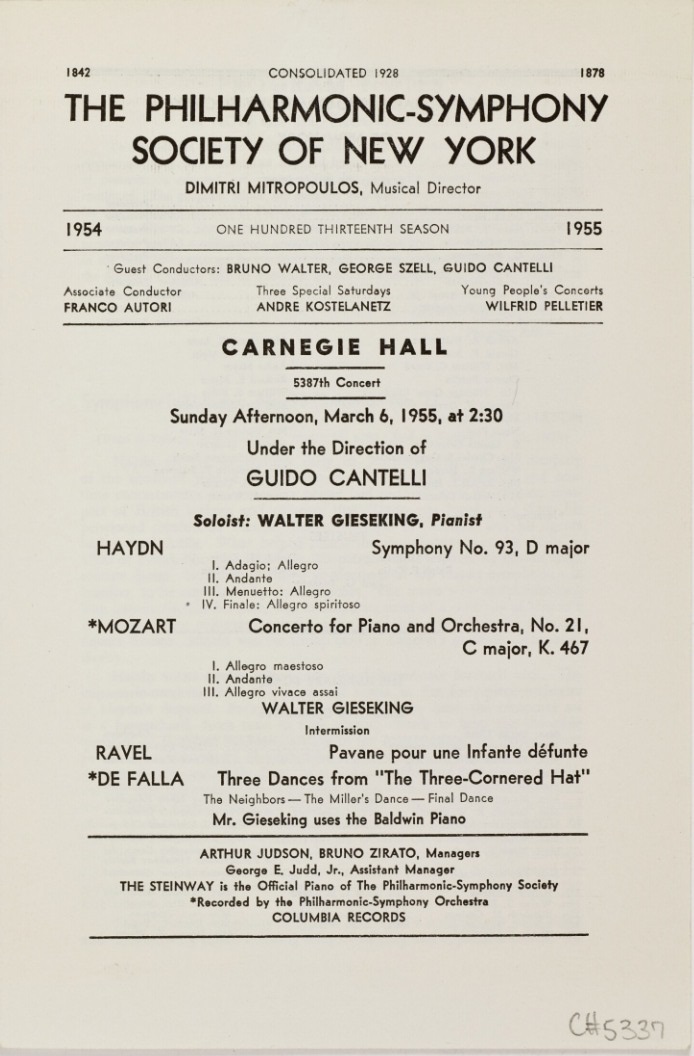
![]()
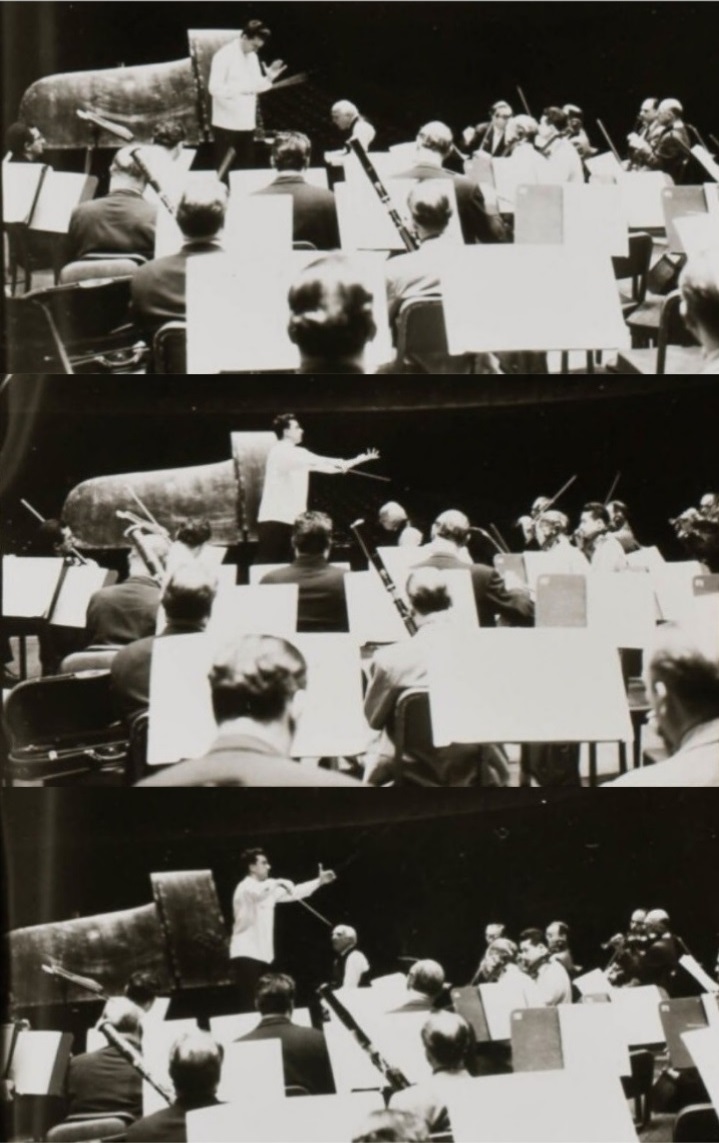
This October 6, 1955 concert illustrates the meeting between Gieseking and Cantelli. It is Gieseking’s return with the NYPO for the first time since 1939 and it is a success. The reciprocal influence between both musicians leads to a memorable performance best described by US critic Bernard H. Haggin (1900-1987) in his 1968 tribute to Cantelli:
‘Many of Cantelli’s performances I found marvelous at the time; and marvelous is the word for those I have heard recently—in particular the one of Mozart’s Piano Concerto K.467. Only Toscanini, in my experience, provided soloists with orchestral contexts as beautifully made and as effective as Cantelli’s; and Toscanini provided the one precedent in my experience for the astounding thing that happens in Cantelli’s performance of K.467. At a New York Philharmonic concert in 1934, I heard Toscanini perform K.467 and 466 with José Iturbi as soloist, and heard Iturbi—under the compulsion of the personality and magnetism of the man on the podium—match the orchestra’s powerful playing with playing of his own that was strikingly different from his customary prettified salon-style playing of Mozart.
And the same thing happens in Cantelli’s performance of K.467. What one expects to hear after the superbly performed orchestral introduction is the finely chiseled miniature-scale playing of Mozart that one always heard Gieseking do; but what one hears instead is a strongly enunciated, strongly phrased playing of melody, a strong-fingered execution of runs and figuration, that may have amazed Gieseking as it must have amazed his listeners at the New York Philharmonic concert in 1955. He had never played Mozart that way before; and he did so then under the same compulsion from Cantelli as Toscanini had exercised on Iturbi. Under that compulsion, Iturbi achieved, and Gieseking achieves, in the extraordinary Andante what I have heard live from no other pianist: an enunciation and articulation of the piano’s long cantilena comparable with Schnabel’s in his recorded performance. And Gieseking’s playing of this cantilena, unlike Schnabel’s, is heard in the context of the superb playing of the constantly active orchestral part—e.g., the poignant woodwind comments intensifying certain of the piano’s statements.’

Sérénade pour orchestre à cordes Op.22 – Václav Talich Prague Soloists’ Orchestra
Enr/Rec: Salle Dvořák (Rudolfinum) – 28 Avril 1951
Sérénade pour instruments à vent, violoncelle et contrebasse Op. 44
Professorum Conservatorii Pragensis Societas Cameralis
Enr/Rec:1951
Source: 33t/LP Supraphon SUA 10326
Les deux Sérénades de Dvořák sont des œuvres magnifiques qui ne sont pas données assez souvent au concert.
Talich nous en livre son interprétation de référence avec un orchestre de chambre qui a été constitué à l’époque à Prague pour réaliser des enregistrements discographiques. Il avait certes fondé l’Orchestre de Chambre Tchèque en 1946 avec des étudiants du Conservatoire de Prague, mais l’ensemble a été contraint de se dissoudre en 1948.
La ‘Societa Cameralis’, ensemble qui regroupait des professeurs du Conservatoire de Prague, pour l’essentiel des instrumentistes à vent, et aussi chefs de pupitres des orchestres pragois, en somme un équivalent du ‘Wiener Oktett’, a été constitué en 1951 par le hautboïste Adolf Kubát (1899-1980). Il a joué dans de nombreux pays un répertoire étendu qui comprenait également des œuvres des anciens compositeurs tchèques et des compositions contemporaines. Son interprétation est bien dans la lignée de celle de Talich.
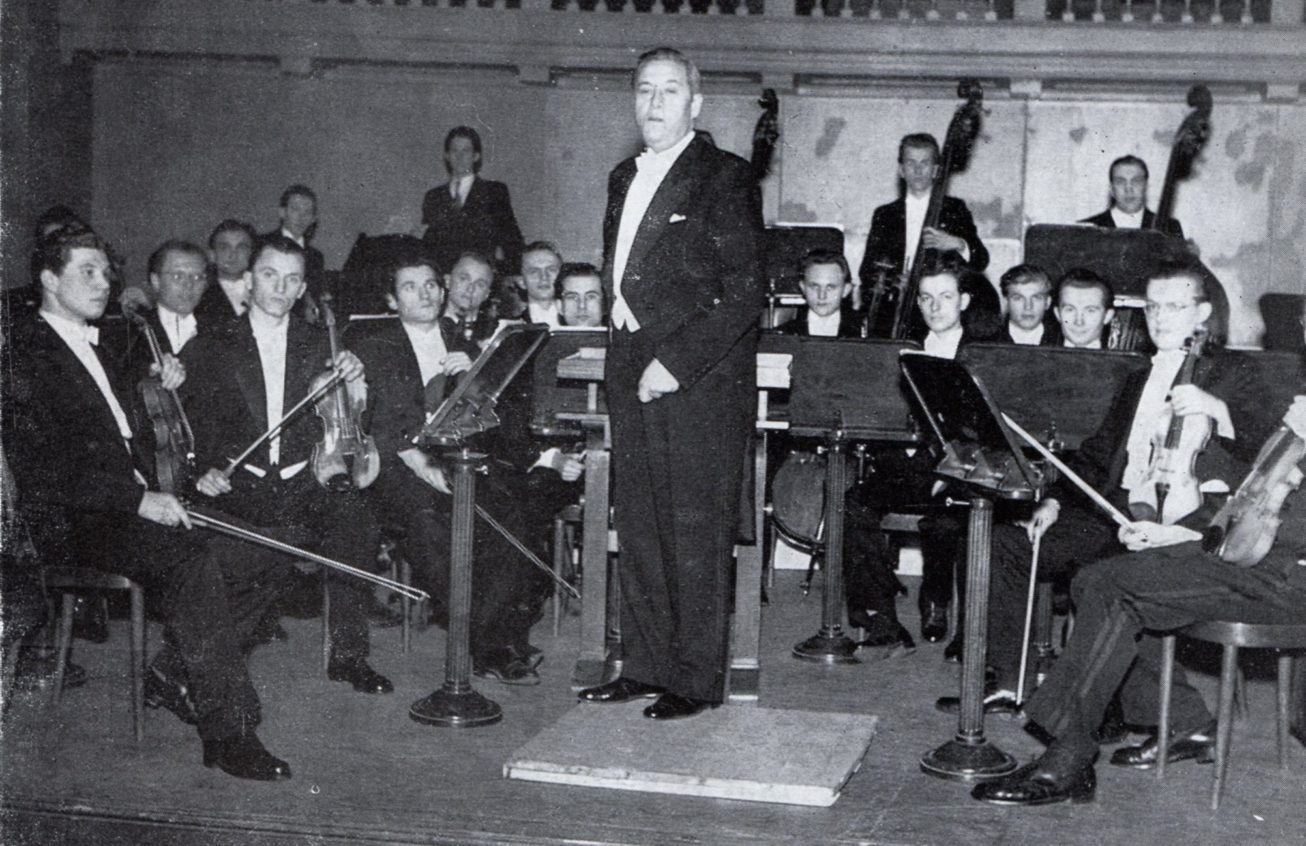
Václav Talich – Orchestre de Chambre Tchèque/Czech Chamber orchestra (1947)
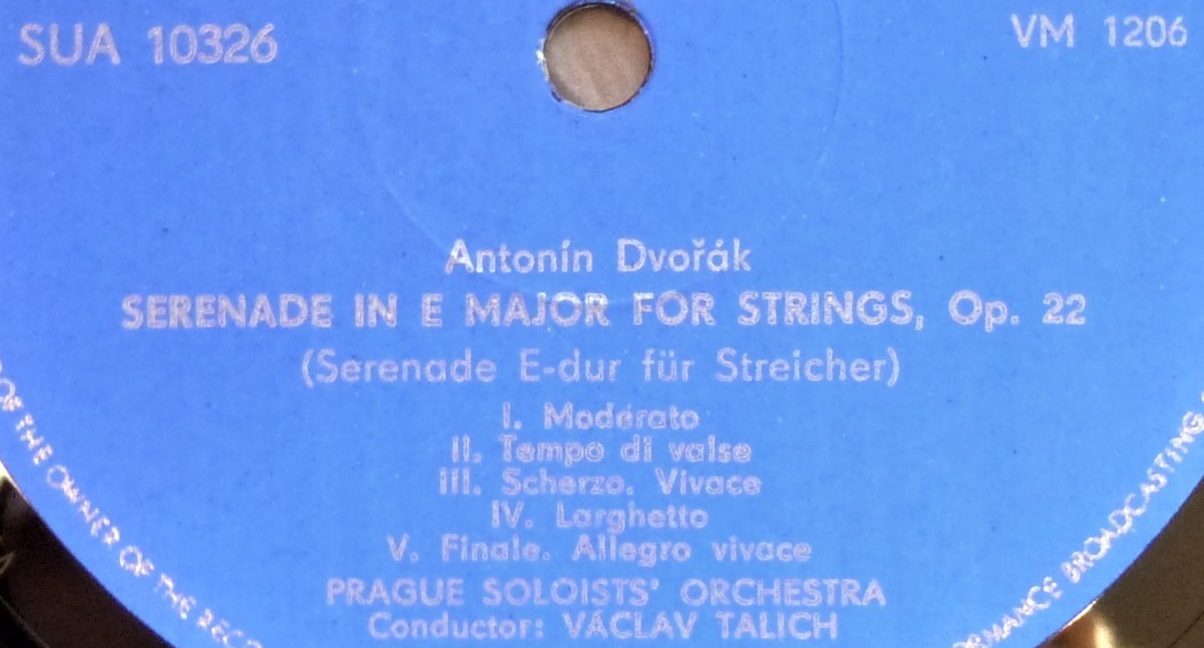

Dvořák’s two Serenades are wonderful works that are not performed often enough.
Talich gives us a reference performance with a chamber orchestra which was then built up in Prague for commercial recordings. Indeed, he established the Czech Chamber Orchestra in 1946 with students from the Prague Conservatory, but it was obliged to disband in 1948.
The ‘Societa Cameralis’, made up of teachers of the Prague Conservatory, mainly wind players, and also first desks of the Prague orchestras, thus a kind of Czech equivalent of the ‘Wiener Oktett’, was grounded in 1951 by oboist Adolf Kubát (1899-1980). It has performed in various countries a large repertoire which also included works by old Czech masters as well as modern compositions. Its performance is well in line with Talich’s.
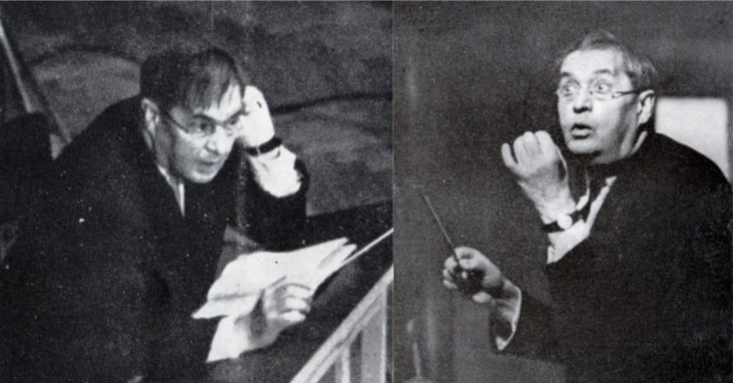
Václav Talich (1942)

Kathleen Ferrier
Brahms Alt-Rhapsodie Op.53: Chœur d’Hommes et Orchestre de la Radio Danoise (Symfoniorkestret /Statsradiofoniens Mandskor: Svend S. Schultz)
dir: Fritz Busch
2 Lieder: Von ewiger Liebe Op43-I – Wir wandelten Op96-II Phyllis Spurr, piano
Radio Studio n°1 – 6 octobre 1949 Source: 33t/LP Danacord DACO 114
___________
Mahler Kindertotenlieder: WPO Bruno Walter
Kingsway Hall 4 octobre 1949
Prod: Walter Legge/Leonard Smith – Eng: Douglas Larter
Source 33t/LP: Angel Japan EAC-57048
En l’espace de deux jours, Kathleen Ferrier nous a offert deux enregistrements majeurs.
Tout d’abord à Londres où le Philharmonique de Vienne (WPO) était présent du 28 septembre au 6 octobre 1949 au cours d’une tournée dirigée par Furtwängler qui rejoindra ensuite Paris, Genève et Zürich.
Ferrier et Walter, de retour d’Edimbourg, ont donné à Londres les 1 et 2 octobre deux concerts Mahler avec les Kindertotenlieder et la Deuxième Symphonie (BBC SO and Choral Society).
Le 4, Furtwängler a dirigé avec le WPO un concert Brahms avec Menuhin, et une séance d’enregistrement a pu être programmée l’après-midi (14h30-17h30) au Kingsway Hall pour capter les Kindertotenlieder avec Bruno Walter.
Walter dirigea un concert londonien avec le WPO le 6. Mais, ce fut sans Ferrier qui chantait ce jour-là la ‘Alt-Rhapsodie’ avec Fritz Busch à Copenhague. De toutes façons, avec le WPO à Londres, elle n’aurait pas pu chanter l’œuvre de Brahms : Furtwängler avait déjà mis la ‘Alt-Rhapsodie’ au programme de son concert du 28 septembre (avec Mary Jarred).
Le programme dirigé par Fritz Busch avec son Orchestre de la Radio Danoise comprenait la Symphonie n°7 Op.70 de Dvorak (à l’époque dénommée ‘n°2’ comme lors de sa publication), et en deuxième partie, un ou plusieurs airs de l’ ‘Orphée’ de Gluck, puis la Rhapsodie Op.53 de Brahms et enfin les Métamorphoses d’Hindemith:
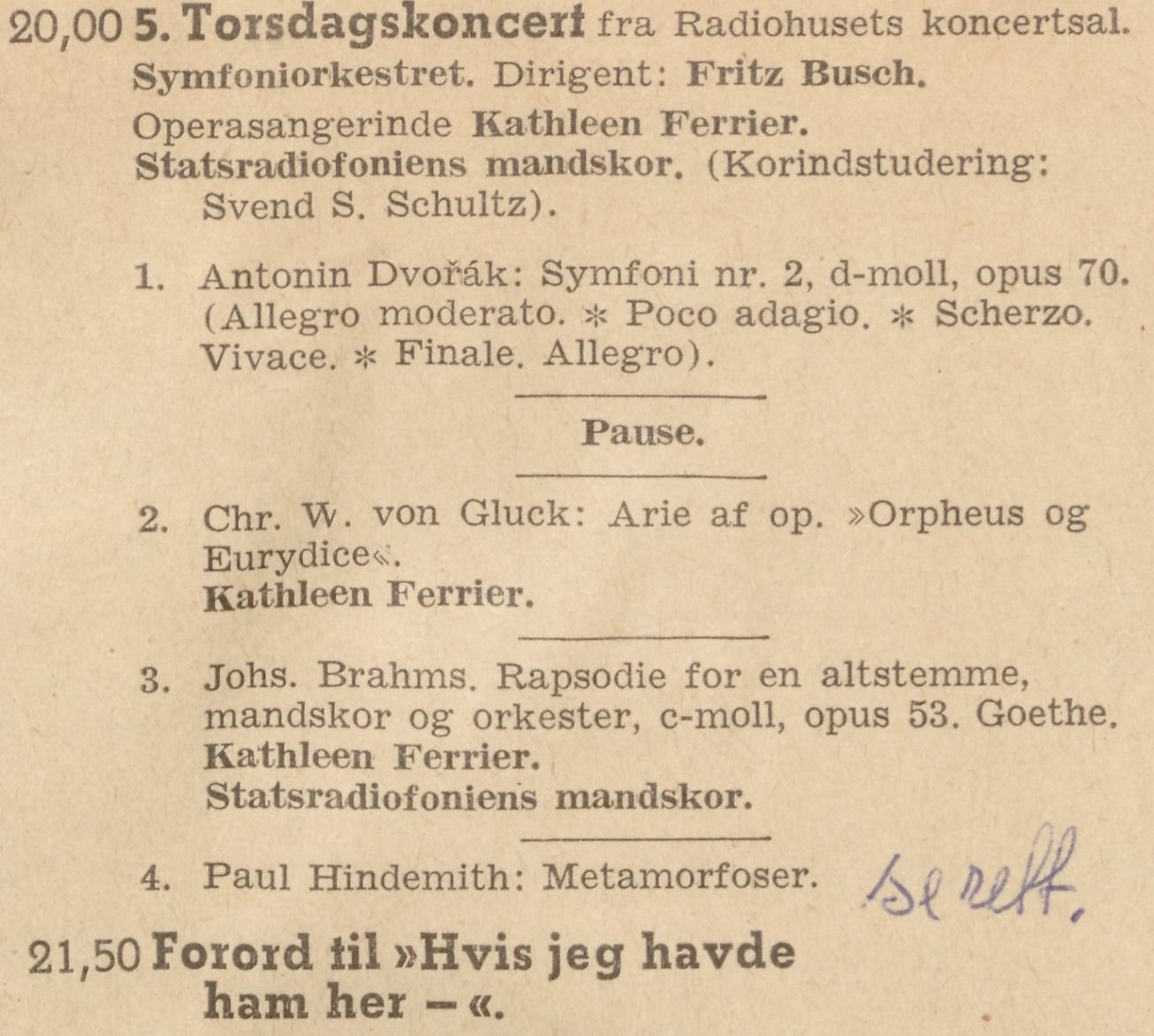
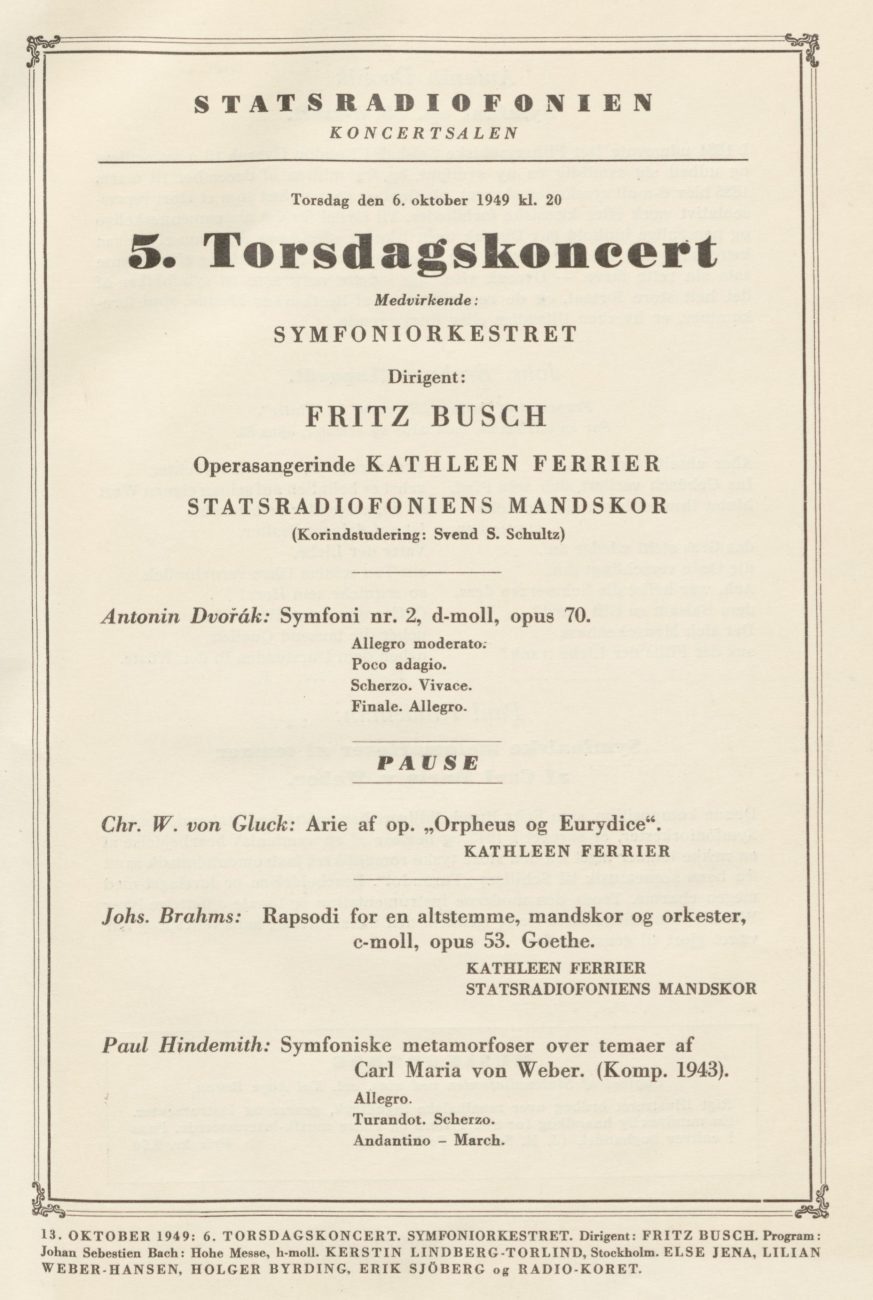
On voit que les deux Lieder de Brahms, probablement joués en bis, dans lesquels Ferrier est accompagnée par sa pianiste venue spécialement pour sa tournée en Scandinavie, ne figurent pas dans ce programme officiel. On les trouve par contre avec Gluck dans une feuille annexe de la Radio:

L’enregistrement de la Rhapsodie Op.53 a été complété par des sources provenant d’enregistrements privés de l’émission de la Radio Danoise pour compenser les parties dégradées de l’archive officielle. Les deux Lieder sont incomplets. Il manque les six premiers vers du premier Lied, et le début de l’introduction pianistique de l’autre.
Kathleen Ferrier et Fritz Busch se sont retrouvés avec l’Orchestre de la Radio Danoise au Festival d’Edimbourg, le 28 août 1950, avec le Royal Choral Union d’Edimbourg pour cette Rhapsodie Op.53.
Fritz Busch avait prévu de faire son grand retour à Berlin en mars 1952. A cette occasion, il avait invité Kathleen Ferrier à ses concerts qui devaient avoir lieu avec les 16 et 17 mars avec l’Orchestre de la RIAS. Sa disparition en septembre 1951 a réduit ce projet à néant.
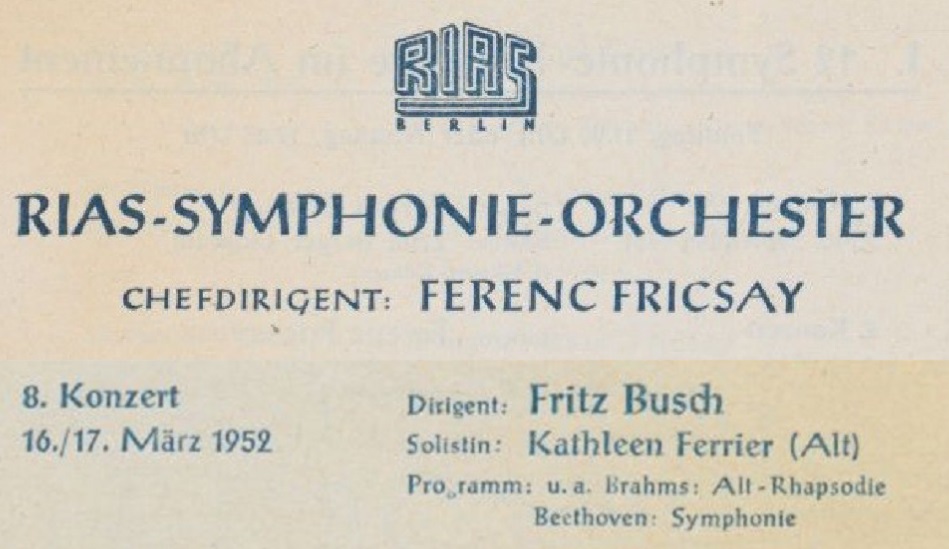
____________

____________
Within two days, Kathleen Ferrier offered us two major recordings.
To start with, in London where the Vienna Philharmonic (WPO) was present between 28 September to 6 October during a tour conducted by Furtwängler which later joined Paris, Geneva and Zürich.
Ferrier and Walter, back from d’Edinburgh, gave on October 1 and 2 two Mahler concerts in London with the Kindertotenlieder and the Second Symphony (BBC SO and Choral Society).
On the 4th, Furtwängler conducted a Brahms concert with Menuhin and the WPO, and an afternoon recording session (2.30pm – 5.30pm) has been set at Kingsway Hall to record the Kindertotenlieder with Bruno Walter.
Walter took the opportunity of being in London to conduct one concert with the WPO on the 6th. But it was without Ferrier who, on that very day, sang the ‘Alt-Rhapsodie’ with Fritz Busch in Copenhagen. Anyway, with the WPO in London, she might not have sung the work by Brahms : Furtwängler already put the ‘Alt-Rhapsodie’ at the program of his concert on 28 September (with Mary Jarred).
The programme conducted by Fritz Busch and his Orchestra of the Danish Radio was comprised of Dvorak’s Symphony n°7 Op.70 (then named ‘n°2’ as when it was published), and for the second part, Arias from Gluck’s Orpheus, then the Rhapsodie Op.53 by Brahms and to end with, Hindemith’s Metamorphosen:

We see that the two Brahms’Lieder, probably performed as encores, in which Ferrier is accompanied by her pianist who came especially for her Scandinavian tour, are not mentioned in this official programme. They are however found with the Gluck item in an extra Radio programme sheet:

The recording of the Rhapsody Op.53 was completed by private sources coming from the broadcast of the Danish Radio Danoise to compensate for the unusable parts of the official archive. Both Lieder are incomplete. The six first verses of the first Lied are missing, as well as the beginning of the piano introduction of the second.
Kathleen Ferrier and Fritz Busch met again with the Danish Radio Orchestra at the Edinburgh Festival on 28 August 1950, with the Edinburgh Royal Choral Union for this Rhapsody Op.53.
Fritz Busch scheduled his postwar return to Berlin for March 1952. He seized the opportunity for inviting Kathleen Ferrier to his concerts that were to take place on 16 and 17 March with the RIAS Orchestra. His death in September 1951 ruined this project.

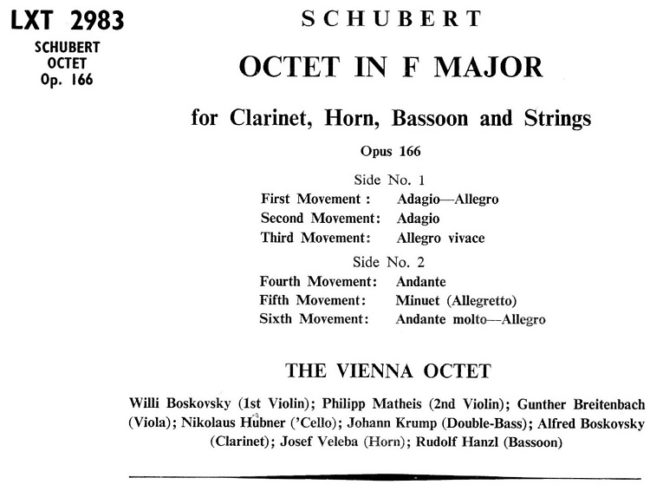
Willi Boskovsky Violine I, Philipp Matheis, Violine II; Günther Breitenbach, Bratsche;
Nikolaus Hübner, Cello; Johann Krump Kontrabass;
Alfred Boskovsky, Klarinette ; Josef Veleba, Horn ; Rudolf Hanzl, Fagott
Schubert Oktett Op.166 D.803
Enregistrement /Recording: Wien Musikvereinsaal – 26 & 27 April 1954
Pr: Victor Olof; Eng: Cyril Windebank
Source 33t/LP: Decca LXT 2983
‘Wenn man Schubert gehört hat, kann einem nichts Gescheites mehr einfallen’
(Richard Strauss)
L’Octuor de Vienne (Wiener Oktett) a joué cet Octuor en public un grand nombre de fois et il l’a enregistré à plusieurs reprises.
Si on s’en tient à la formation d’origine dont Willi Boskovsky était le premier violon, on a:
1- Genève (Studio Radio) – Juillet 1948
2- Wien Musikvereinsaal – 26-27 avril 1954
3- Wien Sofiensaal – 20-29 mars 1958
L’enregistrement 78 tours de 1948 n’a pas été réédité, de même que l’enregistrement mono de 1954, au bénéfice de l’enregistrement de 1958 qui a l’avantage de la stéréo.
Au cours de l’année 1948, les musiciens du Wiener Oktett et du WPO ont eu l’occasion de se produire lors de deux concerts à Montreux en présence de deux auditeurs prestigieux, Richard Strauss et son épouse Pauline de Ahna, qui y résidaient alors.
Le premier a été donné à la Kursaal le 30 avril 1948 par le Wiener Oktett avec au programme le Septuor de Beethoven et l’Octuor de Schubert (annonce dans le ‘Journal de Montreux’ du 29 avril 1948):
 Richard Strauss était assis au premier rang d’orchestre et il a tout particulièrement apprécié l’exécution de l’Octuor de Schubert. Quand il s’est rendu dans la loge des musiciens à la fin du concert, ceux-ci lui ont demandé s’il ne pouvait pas composer une œuvre pour son ensemble. Mais Richard Strauss leur fit signe que non et leur dit alors la phrase en exergue: ‘Quand on a entendu Schubert, rien de bien valable ne peut plus venir à l’esprit’.
Richard Strauss était assis au premier rang d’orchestre et il a tout particulièrement apprécié l’exécution de l’Octuor de Schubert. Quand il s’est rendu dans la loge des musiciens à la fin du concert, ceux-ci lui ont demandé s’il ne pouvait pas composer une œuvre pour son ensemble. Mais Richard Strauss leur fit signe que non et leur dit alors la phrase en exergue: ‘Quand on a entendu Schubert, rien de bien valable ne peut plus venir à l’esprit’.
Un peu plus tard, le 5 juin, les Wiener Philharmoniker (WPO) ont, au cours d’une courte tournée en Suisse sous la direction de Furtwängler, donné un concert à Montreux, dans la Salle du Pavillon. Le programme publié à l’avance comprenait: Mozart Sérénade ‘Gran Partita’ K.361; Schubert Symphonie n° 8 ‘Inachevée’ et Beethoven Symphonie n° 3. En raison de la présence de Richard Strauss dans la salle, son ‘Don Juan’ a été joué à la place de la Symphonie de Schubert.

Dans le Journal de Montreux du 7 juin, on pouvait lire: ‘Nous avons parfois dans un concert, l’impression que l’interprétation d’un certain morceau représente l’interprétation type, idéale, de ce morceau, celle qui le réalise avec adéquation. Eh bien, Furtwängler nous a semblé donner une telle interprétation de ‘Don Juan’. Peut-être que Richard Strauss partage notre avis, lui qui assistait au concert, et que la foule enthousiaste a applaudi en même temps que Furtwängler.’
Et en effet, à la fin du concert, le compositeur alla dans sa loge pour en remercier Furtwängler*, très touché. Frau Strauss dit alors à son mari: ‘Aussi beau que ça, je ne l’ai jamais entendu de ta part’ (‘So schön habe ich das von dir noch nie gehört’). Et Strauss de répliquer: ‘Bon, mais ce n’est tout de même pas lui qui l’a composé!’ (‘Na ja, dafür hat er‘s net komponiert!’).
Fin novembre et début décembre 1947, Furtwängler et treize instrumentistes à vents du WPO ont enregistré la Gran Partita’ de Mozart. En juillet 1948, le Wiener Oktett a mis en disques l’Octuor de Schubert. On peut imaginer que ces deux enregistrements restituent des interprétations proches de ce que Richard Strauss a pu écouter en concert à Montreux. Pour l‘œuvre de Schubert, en attendant une réédition souhaitable de l’enregistrement de 1948, on peut apprécier la très belle version de 1954, fort bien captée.
* Ce ne fut pas leur seule rencontre. Le couple Strauss a résidé au Montreux Palace de septembre 1947 à mai 1949, et Furtwängler qui habitait à Clarens est parfois venu leur rendre visite en voisin.
______________________________
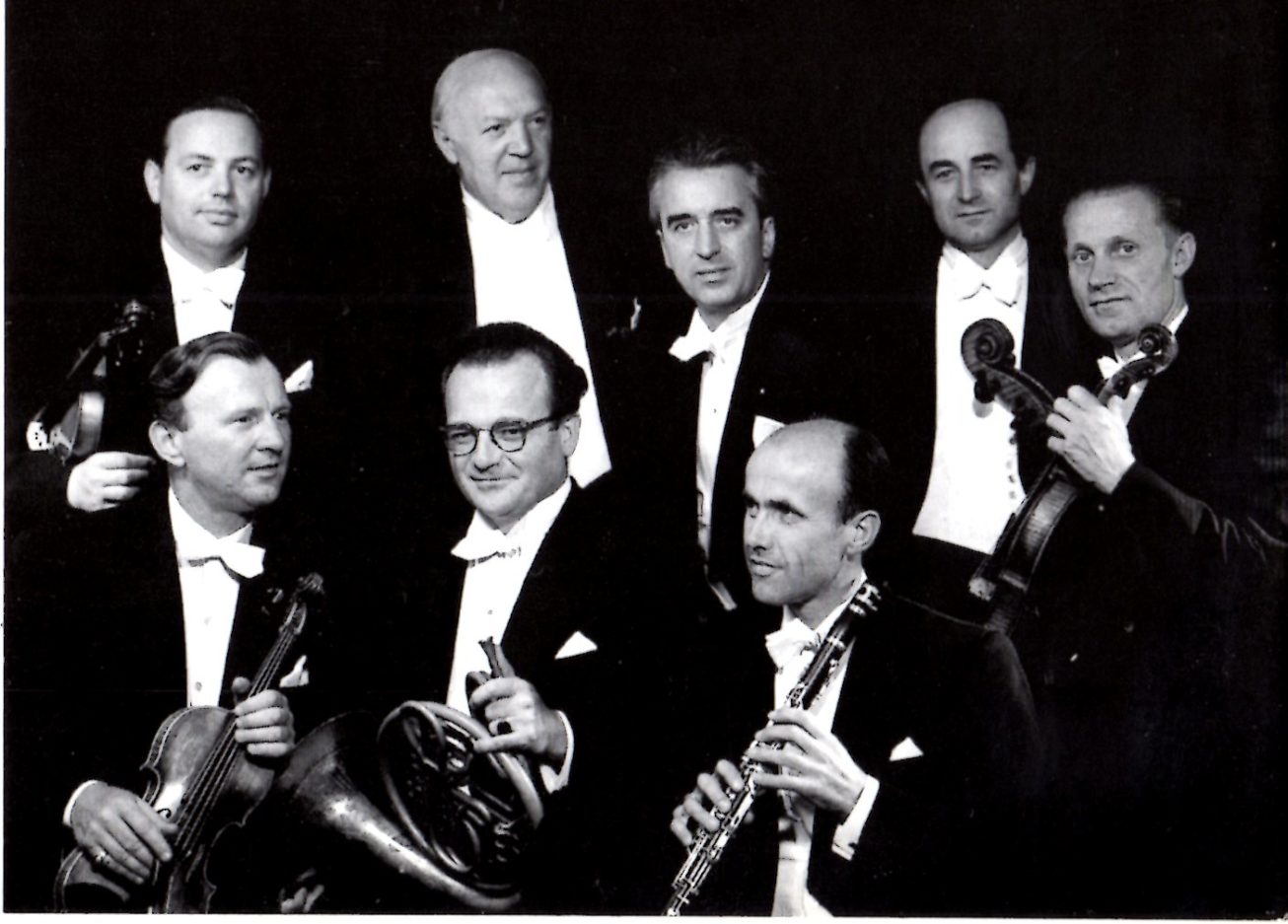
Wiener Oktett
Premier Rang /First Row: Willi Boskovsky; Josef Veleba; Alfred Boskovsky
Deuxième Rang/Second Row: Philipp Matheis; Johann Krump; Rudolf Hanzl; Nikolaus Hübner; Günther Breitenbach
______________________________
The Vienna Octet (Wiener Oktett) performed Schubert’s Octet many times and recorded it several times.
With the original members, with Willi Boskovsky as first violin, we have:
1- Geneva (Studio Radio) – July 1948
2- Wien Musikvereinsaal – 26-27 April 1954
3- Wien Sofiensaal – 20-29 March 1958
The 1948 78rpm recording has not ben re-issued, nor the 1954 mono recording, unlike the 1958 version that benefits from stereo.
In 1948, the musicians from the Wiener Oktett and from the WPO had the opportunity of playing during two concerts in Montreux before two celebrated spectators, Richard Strauss and his wife Pauline de Ahna, who were then living there.
The first was given at the Kursaal on 30 April 1948 by the Wiener Oktett and the program was Beethoven’s Septet and Schubert’s Octet (announcement in the ‘ Journal de Montreux’ of 29 April 1948):
Richard Strauss sat in the first row and he was particularly delighted by the performance of Schubert’s Octet. As he went to the musicians’ dressing-room at the end of the concert, they asked him whether he could compose a work for their ensemble. But Richard Strauss shook his head and then said the above-cited words: ‘When one has heard Schubert, nothing clever may come to the mind any more’.
Somewhat later, on 5 June, the Wiener Philharmoniker (WPO), during a short Swiss tour conducted by Furtwängler, gave a concert in Montreux, in the ‘Salle du Pavillon’. The program that was published in advance was comprised of: Mozart Serenade ‘Gran Partita’ K.361; Schubert’s Symphony n° 8 ‘Unfinished’ and Beethoven’s Symphony n° 3. Because Richard Strauss attended the concert, his ‘Don Juan’ was performed instead of Schubert’s Symphony.

In the 7 June edition of the ‘Journal de Montreux’, one read: ‘ In a concert, we have sometimes the impression that the interpretation of a given piece represents the reference, the ideal interpretation of that piece, that is the adequate rendering. Well, Furtwängler seemed to us to have given such an interpretation of ‘Don Juan’. Perhaps Richard Strauss shares our view, he who attended the concert, and who was applauded by the enthusiastic crowd, at the same time as Furtwängler.’
And indeed, at the end of the concert, the composer went to his dressing-room to thank for it Furtwängler*, very moved. Frau Strauss then said to her husband: ‘As beautiful as this, I have never heard from you’ (‘So schön habe ich das von dir noch nie gehört’). Then came Strauss’ reply: ‘Well, however, he is not the one who composed it!’ (‘Na ja, dafür hat er‘s net komponiert!’).
At the end of November and the beginning of December 1947, Furtwängler and thirteen wind players from the WPO recorded the ‘Gran Partita’ by Mozart. In July 1948, the Wiener Oktett committed to disc Schubert’s Octet. One may imagine that these two recordings reproduce interpretations close to what Richard Strauss heard live in Montreux. For the Schubert work, while awaiting a desirable re-issue of the 1948 recording, one may appreciate the very good 1954 version, very well recorded.
* This was not the only time that they met. Strauss and his wife lived at the ‘Montreux Palace’ from September 1947 to May 1949, and Furtwängler who lived in Clarens came sometimes as a neighbour to pay them a visit.
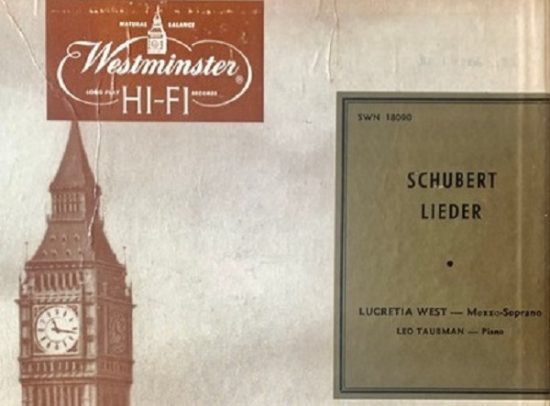
Lucretia West, mezzo-soprano Leo Taubman, piano
Schubert Lieder
An Die Musik D547 – Dem Unendlichen D291 – Wanderers Nachtlied D768
Seligkeit D433 – Die Liebe hat gelogen D751 – Rastlose Liebe D138
Der Tod und das Mädchen D531 – Wiegenlied D498 – Schlummerlied D527
Fischerweise D881 – Im Abendrot D799 – Nacht und Träume D827
Geistertanz D116 – Widerschein* D639 – Wehmut D772
Enregistrement / Recording: 1955
Source: 33t. / LP Westminster WN 18090
La cantatrice américaine Lucretia West (1922-2022) a fait l’essentiel de sa carrière en Suisse et en Allemagne. Une bourse de la ‘John Hay Whitney Fondation’ lui a permis de poursuivre ses études en Belgique et en Suisse. Elle a fait brièvement partie de la ‘New York City Opera Company’ avant de retourner en Europe en 1957 pour le reste de sa carrière. Elle a enseigné en Allemagne jusqu’en 2008 avant de retourner aux Etats-Unis.
Sa discographie officielle se limite à ses enregistrements pour la firme Wesminster notamment avec Hermann Scherchen (Mahler, Mozart) et avec accompagnement de piano, et à l’ ‘Alt-Rhapsodie’ de Brahms avec Knappertsbusch (Decca). Il existe aussi un disque de ‘Spirituals’ pour le Club Français de Disque. Quelques enregistrements radiophoniques réalisées en Europe (Schuricht, Mitropoulos) ont été publiés, mais il est possible qu’il en existe bien d’autres, notamment dans le domaine du Lied.
Bien que considérée comme une mezzo-soprano, elle avait une tessiture proche de celle d’un contralto. Le 9 juin 1958, elle a chanté à Hambourg le ‘Das Lied von der Erde’ de Mahler avec le NDR-Sinfoniker dirigé par Alfred Wallenstein (et le ténor Richard Holm), concert retransmis en direct à la radio. Un critique avait apprécié son interprétation et parlé à son sujet de ‘Bratschentimbre’ (timbre d’alto, comme l’instrument à cordes).
Le programme de ce disque entièrement consacré par une voix aussi grave à des Lieder de Schubert est en soi une rareté. Elle est ci remarquablement accompagnée par Leo Taubman (1907-1966).
* Schubert a écrit plusieurs versions de ce Lied, correspondant à des versions successives du poème. Ici, il s’agit de la 2ème version et de sa première révision. Le texte commence par «Tom lehnt harrend auf der Brücke…’

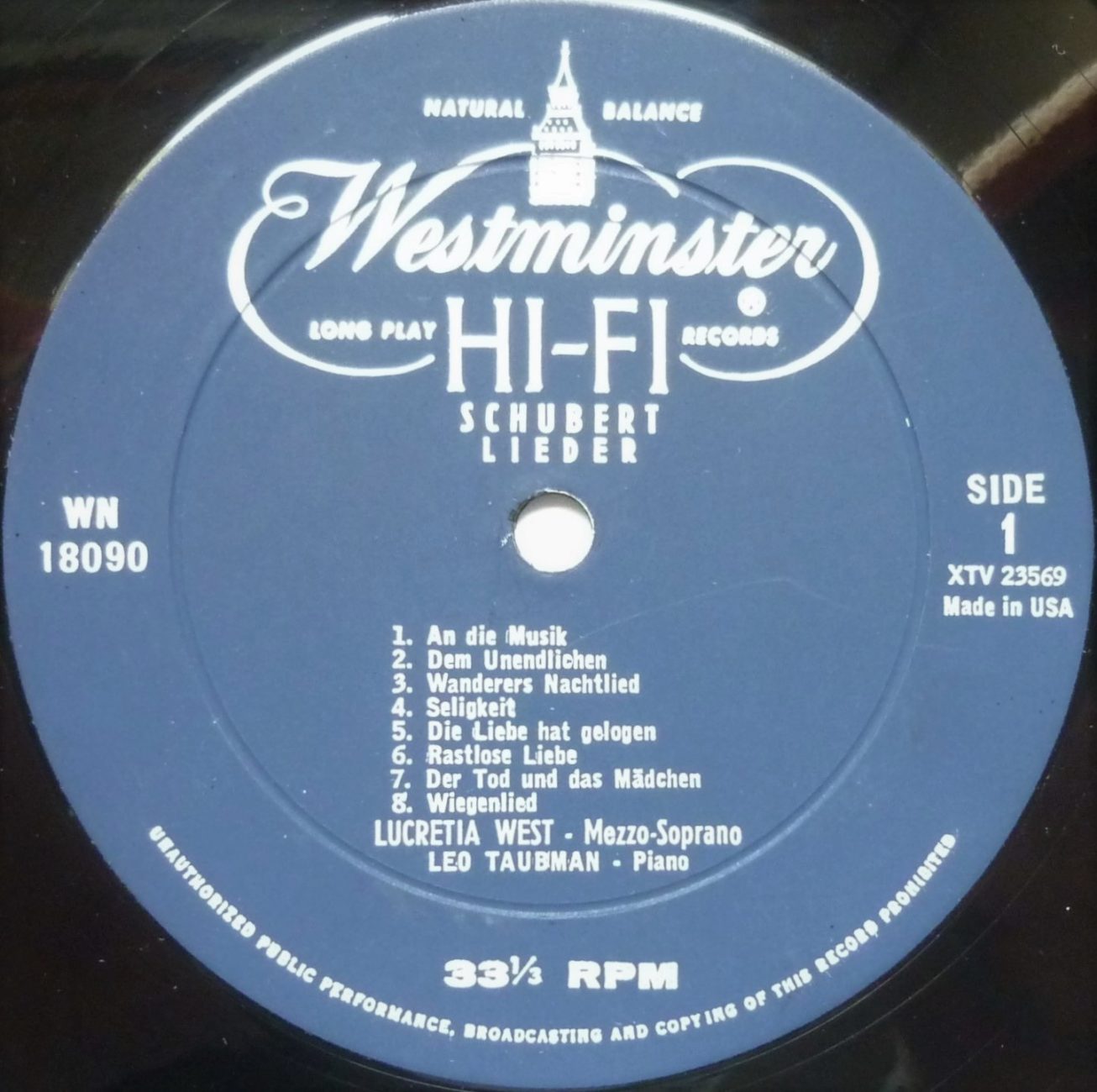
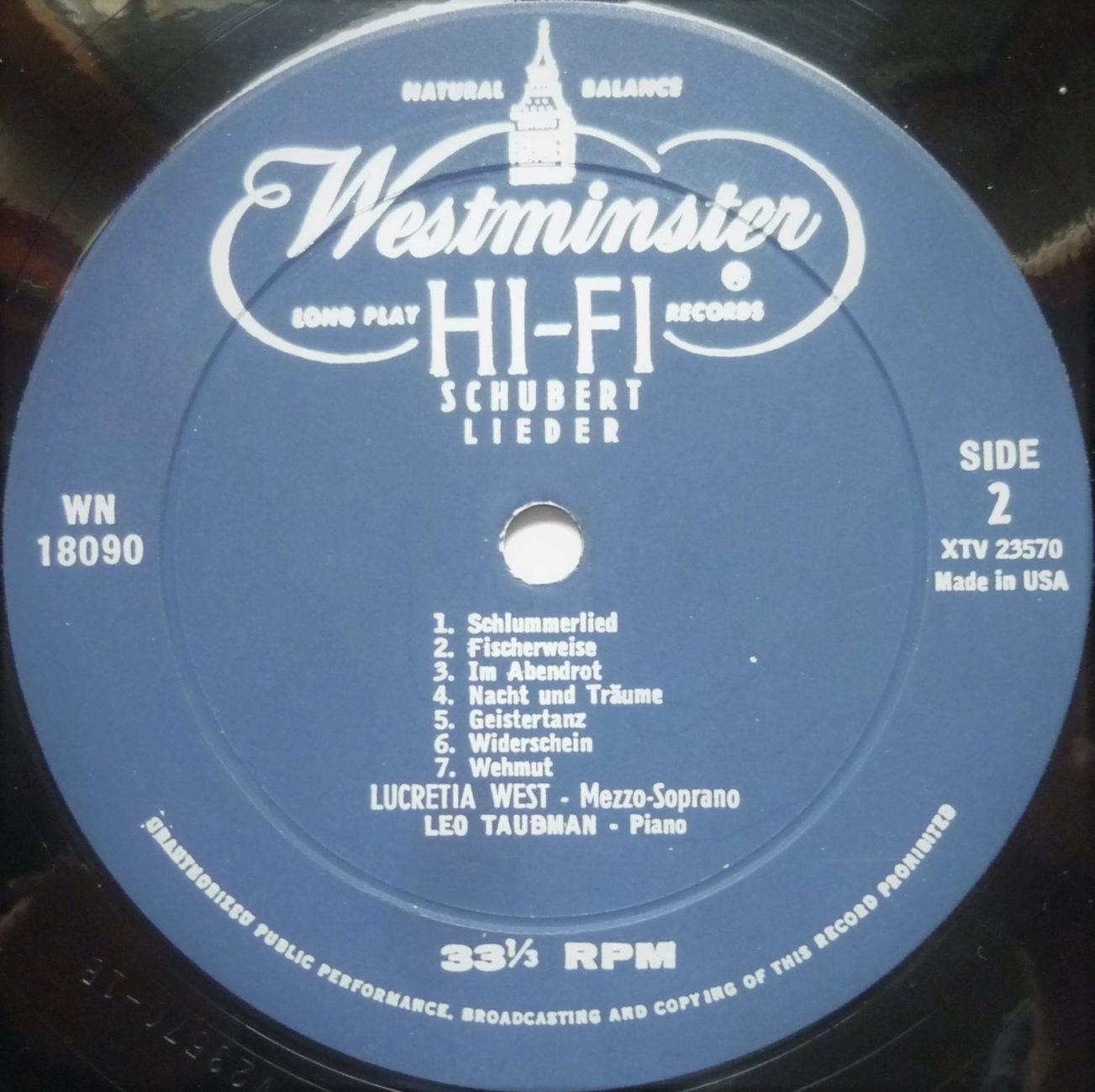
US singer Lucretia West (1922-2022) made most of her career in Switzerland and in Germany. A grant from the ‘John Hay Whitney Fondation’ allowed her to complete her studies in Belgium and in Switzerland. She was for a short period a member of the ‘New York City Opera Company’ before returning to Europe in 1957 for the remainder of her career. She taught in Germany before moving back to the United States in 2008.
Her official discography is merely comprised of her recordings for ‘Wesminster’, mainly with Hermann Scherchen (Mahler, Mozart) and with piano accompaniment, and of the ‘Alt-Rhapsodie’ by Brahms with Knappertsbusch (Decca). There also exists a LP with ‘Spirituals’ for ‘Le Club Français de Disque’. A few Radio recordings made in Europe (Schuricht, Mitropoulos) have surfaced, but it might well be that many others exist, especially with Lieder.
Although nominally a mezzo-soprano, she had a tessitura close to that of a contralto. On 9 June 1958, she sang in Hamburg Mahler’s ‘Das Lied von der Erde’ with the NDR Orchestra conducted by Alfred Wallenstein (the tenor was Richard Holm). The concert was broadcast live. A music critic then praised her performance and wrote about her of a ‘Bratschentimbre’ (viola timbre, like the string instrument).
The program of this LP entirely dedicated to Lieder by Schubert by such a low voice is a rarity in itself. She is here remarkably accompanied by Leo Taubman (1907-1966).
* Schubert wrote several versions of this Lied, corresponding to successive versions of the poem. Here, it is the second version and the first revision thereof. The text begins with the following words: «Tom lehnt harrend auf der Brücke…’



